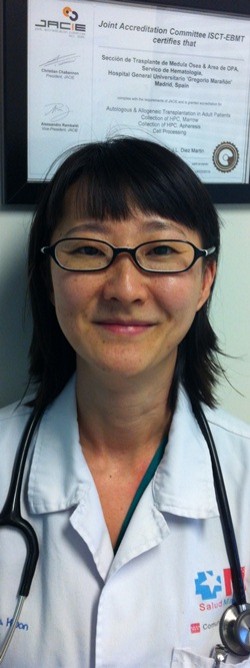Вы здесь
Haplo-Cord Transplants
(Haplo-Cord Transplants are cord blood transplants supported by half-matched bone marrow)
When a patient needs a stem cell transplant, the physician's goal is to find donor stem cells that match the patient's Human Leukocyte Antigens, also known as HLA type. The ideal donor is a sibling who is an exact match, but only about 30% of patients can find a matching donor in their family. The next best thing is a matching unrelated donor (MUD) of bone marrow. But here too, not all patients can find a match. It is especially difficult for patients of African descent or mixed ancestry to find matching bone marrow donors. At this point, the next step is to look for a cord blood donation that is a close enough match.
Cord blood transplants have both advantages and disadvantages for patients. Their biggest advantage is that the HLA types do not have to match exactly between the donor and patient. Studies have shown that, when looking at the 6 most important HLA types, cord blood transplants with only 4 of 6 HLA match are just as successful as bone marrow transplants that are 6 of 6 matched, in terms of long-term patient survival. Another advantage of cord blood stem cells is that they can be available in much less time than it takes to activate a registered bone marrow donor. But the biggest disadvantage of cord blood transplants is that it takes longer for the stem cells from cord blood donations to "engraft", so that the patient's immune system recovers. That is very dangerous because, while waiting for engraftment, the patient has no ability to fight disease and is at risk of a fatal infection.
At the Hospital General Universitario Gregorio Marañon, in Madrid, our research on cord blood transplants is focused on ways to combine cord blood stem cells with other donated stem cells so that patients will receive a full cell dose and will have faster engraftment. In this way we hope to push back the frontier of cord blood transplantation, and make the procedure both safer and available to more patients.
Our group has developed a strategy called "dual" or "haplo-cord" transplants: patients receive stem cells from a single cord blood unit combined with stem cells from the bone marrow of a donor who is "haploidentical" to the patient. A haploidentical donor is one who is a half-match. A haplotype is a series of genes that are close together on a chromsone and are usually inherited as a group. People inherit half their HLA types from their mother and half from their father. But since the HLA types are grouped into haplotypes, another way of looking at it, is that we receive one haplotype from the mother and one from the father. Thus, each parent is by definition a haploidentical matching donor, and 90% of people can find a haploidentical donor among their relatives. It is not difficult to find a haploidentical donor in a registry of bone marrow donors.
It has been known for many years that haploidentical bone marrow donors are not close enough matches for successful stem cell transplants; there is a strong chance the patient will experience graft failure or terrible graft versus host disease. However, when matching cord blood cells are given together with haploidentical donor cells in a haplo-cord transplant, the two stem cell sources support each other and produce a better outcome than either alone.
Haplo-cord transplants have been shown to reduce the patient's engraftment time, because the haploidentical donor cells engraft faster than the cord blood cells. However, this engraftment is transient, and only acts as a bridge - eventually the stem cells from the cord blood donor take over, replace the haploidentical donor cells, and engraft permanently.
Our group conducted the first clinical trial to compare outcomes of haplo-cord transplants versus MUD bone marrow transplants, for patients diagnosed with high-risk leukemias. In this study, 25 patients received traditional MUD bone marrow transplants and 20 patients received haplo-cord transplants. The median time for bone marrow engraftment was similar in the two groups, 16 days for MUD and 14 days for halo-cord. Incidents of serious post-transplant infection were also similar between the two groups.
The key result of the study was that outcome measures were comparable between the two groups of patients: haplo-cord transplants are just as good as traditional MUD bone marrow transplants for long-term survival. These outcome measures include overall survival, disease-free survival, and toxic-related deaths.
A second study result which is also very important was that the haplo-cord patient group had significantly less graft versus host disease, only 5% in the haplo-cord group versus 40% in the MUD group. Graft versus host disease is a major complication after any transplants with donor cells, and can seriously compromise the quality of life experienced by transplant survivors.
Taking the two results together, our study showed that haplo-cord transplants are just as good as traditional MUD bone marrow transplants for ensuring patient survival, and can be better than MUD transplants for patient quality of life post-transplant. Haplo-cord transplants confer the best qualities of both bone marrow and cord blood transplants: they have the shorter engraftement time of bone marrow transplants and the lower incidence of graft versus host disease of cord blood transplants.
In the future, we hope that more of our colleagues will adopt the haplo-cord option for their patients who lack a bone marrow donor or who require urgent transplantation. Haplo-cord transplants merit broader exploration through clinical trials for different hematologic diseases.
Reference
- Single Cord Blood Combined with HLA-Mismatched Third Party Donor Cells: Comparable Results to Matched Unrelated Donor Transplantation in High-Risk Patients with Hematologic Disorders
Mi Kwon, Pascual Balsalobre, David Serrano, A. Pérez Corral, Ismael Buño, Javier Anguita, Jorge Gayoso, Jose Luis Diez-Martin
BBMT 19(1): 143-149, January 2013 (Abstract)



